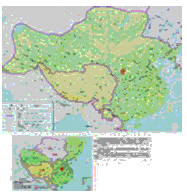环绕北部湾的广东沿海地区自古以来一直在我国海外贸易中占有重要地位。
材料一:《唐朝对外主要交通路线图》

材料二:唐宋时期,许多阿拉伯商人从海路到广东等东南沿海经商,阿拉伯商人不仅从搭乘的中国海船上学会了指南针导航技术,井把这种先进技术传到了欧洲,还把阿拉伯的伊斯兰教以及天文、医学等知识传到了中国。
材料三:以下是宋、明文献中有关古代海外贸易的记载:上(宋高宗)谕大臣曰:“广南市舶(指广东的海外贸易)利人甚厚,提单官(管理海关税收官员)宜得人而久任,庶蕃商肯来,动得百十万缗(钱币),皆宽民力也。” ——《建炎以采系年要录》
“海外之有余,补内地之不足,内地无足轻重之物,载之番岛皆为珍品。是以沿海居民操作技艺及女工针锈,皆于洋船行销,岁收入番岛银洋百十万于我中土。”“南洋未禁之先,闽广家给人足,游手无赖亦为欲富所驱,尽入番岛,鲜有在家饥寒窃劫为非之徒。” ——《中国古代史纲要》
材料四:顺治、康熙年间,面对以台湾等沿海岛屿为依托的郑成功等抗清武装,清廷厉行“海禁”,“寸板不许下水”。清军收复台湾后曾短期开放“海禁”,但不久即又恢复……,乾隆57年(1792年),英国派使臣来华交涉通商事宜,向清廷提出开放通商口岸、自由通商、租占沿海岛屿居住等要求,遭到乾隆帝的严词拒绝。乾隆帝在写给英王的谕旨中指出:“尔国所请,与天朝体制不合,断不可行”,“天朝物产丰盈,无所不有,原不借外夷货物以通有无。”
材料五:乾隆帝命纪昀编写的《四库全书总目》指出:“欧罗巴人推算之密,工匠制作之巧,实愈前古,其议论夸诈迂怪亦为异端之术,国朝节取其技能,禁传其学术,具有深意矣!”。
(1)依据材料一和所学知识,指出广东沿海地区在唐代海外贸易中的重要地位。
____________________________________________________________________________________
____________________________________________________________________________________
(2)依据材料二、三,归纳概括我国古代海外贸易产生的影响。
____________________________________________________________________________________
____________________________________________________________________________________
____________________________________________________________________________________
(3)依据材料四、五,归纳概括清政府推行“海禁”政策的原因。从世界经济发展潮流的角度,分析乾隆时期的“海禁”政策对我国社会经济产生的严重危害。
____________________________________________________________________________________
____________________________________________________________________________________
____________________________________________________________________________________
____________________________________________________________________________________
(1)重要地位:广东沿海是海上“丝绸之路”贸易的起点。也是我国同东南亚、南亚、西亚各国海外贸易的中心。
(2)影响:①向西方各国传播我国的指南针等先进科技成就;②向国内传播西方各国的天文、医学等科技知识;③增加政府收入,减轻百姓负担;④满足国内市场需求;⑤增加沿海居民收入,改善民生;⑥有利于安定社会秩序。
(3)原因: * * 沿海的抗清武装,防止西方异端思想的传播,阻止西方的扩张侵略;自以为物产丰富,不需要对外贸易。危害:严重阻碍国内商品经济和资本主义发展,无法吸收西方工业革命的先进科技成果,中国经济远远落后于资本主义工业化的世界潮流。
